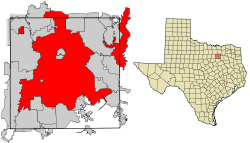Dallas, Texas
USGenWeb >> TXGenWeb >> Dallas County >> Towns & Communities >> Dallas, Texas
 |
|
| Latitude |
32°46′33″N 32.7830556 324659N |
| Longitude |
96°47′48″W -96.8066667 0964824W |
| Elevation feet/meters |
430/131 |
| Zip Code | 75201-75212 75214-75238 75240-75254 75260-75267 75270, 75275 75258, 75277 75283-75287 75301, 75303 75312-75313 75310, 75315 75320, 75323 75326, 75334 75339-75340 75342-75344 75354-75360 75367-75368 75336, 75376 75370-75374 75378-75382 75389-75394 75387 |
| Founded | |
| GNIS FID | 1380944 |
| Dallas TXGenWeb | |
| Cemeteries | |
| Dallas Public Library | |
| Dallas Genealogy Society | |
| Wikipedia | |
| dallascityhall.com | |
Dallas (/ˈdæləs/). On 2 February 1856, Dallas was granted a town charter during the Regular session of the Sixth Texas Legislature. Samuel Pryor was elected the first mayor along with a constable, a treasurer-recorder, and six aldermen. By 1860, the town's population reached 678, including 97 African Americans (mostly enslaved), as well as Belgian, French, German, and Swiss immigrants. By that year, the railroad was approaching from the south, and several stage lines were already passing through the city.
|
||||||||||||||||||||||||||||||||||||||||||||||||||||||||||||||||||||||||||||
In July 1860, a fire broke out in the square, destroying most of the buildings in the business district of Dallas. Out of fear, many white residents assumed that slaves were behind it, and two abolitionists were run out of town. They lynched three African-American slaves, and officials ordered all other slaves in Dallas to be whipped, as part of event that is known as the "Texas Troubles". On the eve of the Civil War in 1861, Dallas County voted 741–237 in favor of secession. On 8 June of that year, a state of war was declared, and citizens were very supportive of the effort. The town was a long way from any battles, and suffered no damage from the war.
.... Read More Wikipedia ....
Jackie McElhaney and Michael V. Hazel
Dallas is on the Trinity River in the center of Dallas County in North Central Texas. It is crossed by Interstate highways 20, 30, 35, and 45. The city was founded by John Neely Bryan, who settled on the east bank of the Trinity near a natural ford in November 1841. Bryan had picked the best spot for a trading post to serve the population migrating into the region. The ford, at the intersection of two major Indian traces, provided the only good crossing point for miles. Two highways proposed by the Republic of Texas soon converged nearby. Unknown to Bryan, however, he had settled on land granted by the republic to the Texan Land and Emigration Company of St. Louis, headed by William S. Peters. Bryan eventually legalized his claim, and the extensive promotional efforts of the Peters colony attracted settlers to the region. In 1844 J. P. Dumas surveyed and laid out a townsite comprising a half mile square of blocks and streets. The origin of the name Dallas is unknown. Candidates include George Mifflin Dallas, vice president of the United States, 1845–49; his brother, Commodore Alexander J. Dallas, United States Navy; and Joseph Dallas, who settled near the new town in 1843. When Dallas County was formed in 1846, Dallas was designated as the temporary county seat; in 1850 voters selected it as the permanent county seat over Hord's Ridge (Oak Cliff) and Cedar Springs, both of which eventually came within its corporate limits. The Texas legislature granted Dallas a town charter on February 2, 1856. Dr. Samuel Pryor, elected the first mayor, headed a town government consisting of six aldermen, a treasurer-recorder, and a constable.
BIBLIOGRAPHY: Sam Hanna Acheson, Dallas Yesterday, ed. Lee Milazzo (Dallas: Southern Methodist University Press, 1977). Elizabeth York Enstam, Women and the Creation of Urban Life: Dallas, Texas, 1843-1920 (College Station: Texas A&M University Press, 1998). Robert B. Fairbanks, For the City as a Whole: Planning, Politics, and the Public Interest in Dallas, Texas 1900-1965 (Columbus: Ohio University Press, 1998). Michael V. Hazel, Dallas: A History of “Big D” (Austin: Texas State Historical Association, 1997). Glenn M. Linden, Desegregating Schools in Dallas: Four Decades in the Federal Courts (Dallas: Three Forks Press, 1995). William L. McDonald, Dallas Rediscovered: A Photographic Chronicle of Urban Expansion, 1870–1925 (Dallas: Dallas County Historical Society, 1978). Jacquelyn Masur McElhaney, Pauline Periwinkle and Progressive Reform in Dallas (College Station: Texas A&M University Press, 1998). Jacquelyn Masur McElhaney, Pauline Periwinkle and Progressive Reform in Dallas (College Station: Texas A&M University Press, 1998). Darwin Payne, Dallas: An Illustrated History (Woodland Hills, California: Windsor, 1982). Darwin Payne, Big D: Triumphs and Troubles of an American Supercity in the 20th Century (Dallas: Three Forks Press, 2000). John William Rogers, The Lusty Texans of Dallas (New York: Dutton, 1951; enlarged ed. 1960; expanded ed., Dallas: Cokesbury Book Store, 1965). WPA Writers' Program, The WPA Dallas Guide and History, ed. Maxine Holmes and Gerald D. Saxon (Denton: University of North Texas Press, 1992).
Handbook of Texas Online, Jackie McElhaney and Michael V. Hazel, "DALLAS, TX"
.... Read More TSHA ....




